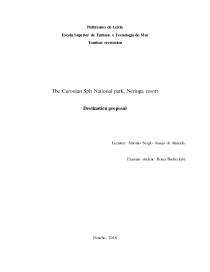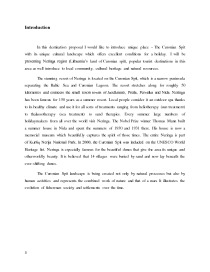The Curonian Spit National Park, Neringa Resort



Introduction. Introduction to the Curonian Spit. The development of tourism in the Curonian Spit. Transportation. Toursit destinations in Neringa resort. The Dead Dunes. Sundial. The Hill of Witches. The Ethnographic Fishermans’ Museum. Evangelic – Lutheran church. Writers’ Thomas Mann house and museum. Amber Gallery. Artists’ colony. Sandy beaches. Traditional festival and events. Local community. Cultural Heritage. Natural resources. Conclusion. Bibliography.
In this destination proposal I would like to introduce unique place – The Curonian Spit with its unique cultural landscape which offers excellent conditions for a holiday. I will be presenting Neringa region (Lithuania’s land of Curonian spit), popular tourist destinations in this area as well introduce to local community, cultural heritage and natural resources.
The stunning resort of Neringa is located on the Curonian Spit, which is a narrow peninsula separating the Baltic Sea and Curonian Lagoon. The resort stretches along for roughly 50 kilometres and connects the small resort towns of Juodkrantė, Preila, Pervalka and Nida. Neringa has been famous for 150 years as a summer resort. Local people consider it an outdoor spa thanks to its healthy climate and use it for all sorts of treatments ranging from heliotherapy (sun treatment) to thalassotherapy (sea treatment) to sand therapies. Every summer large numbers of holidaymakers from all over the world visit Neringa. The Nobel Prize winner Thomas Mann built a summer house in Nida and spent the summers of 1930 and 1931 there. His house is now a memorial museum which beautifully captures the spirit of those times. The entire Neringa is part of Kuršių Nerija National Park. In 2000, the Curonian Spit was included on the UNESCO World Heritage list. Neringa is especially famous for the beautiful dunes that give the area its unique and otherworldly beauty. It is believed that 14 villages were buried by sand and now lay beneath the ever-shifting dunes.
The Curonian Spit landscape is being created not only by natural processes but also by human activities and represents the combined work of nature and that of a man. It illustrates the evolution of fisherman society and settlements over the time.
The Curonian Spit stretches for 98 km from Lesnoje in the south to Klaipeda in the north and separates the Curonian Lagoon from the Baltic Sea. The northern 52 km belong to Lithuania (Neringa Municipality theritory) whereas the southern 46 km are a part of Russia (Kaliningrad District). This headland is a result of the interactions of natural forces like wind and waves, but also a damaging human influence. Human habitation dates back to prehistoric times when the Curonian Spit had already been covered with forests. Till the 18th century, the forests had been signif cantly cut down, so that the drifting ing sand threatened settlements, streets as well as cultivated fields and buried several villages for more than one time.
- Travel Individual works
- Microsoft Word 1394 KB
- 2019 m.
- English
- 16 pages (3403 words)
- University
- Roma

















